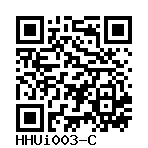A4_W1
HHUi003-C
General
Cell Line |
|
| hPSCreg name | HHUi003-C |
| Cite as: | HHUi003-C (RRID:CVCL_C1TA) |
| Alternative name(s) |
A4_W1
|
| Cell line type | Human induced pluripotent stem cell (hiPSC) |
| Similar lines | |
| Last update | 24th August 2022 |
| User feedback | |
Provider |
|
| Generator | Universitätsklinikum Düsseldorf (HHU) |
| Owner | Universitätsklinikum Düsseldorf (HHU) |
| Derivation country | Germany |
External Databases |
|
| BioSamples | SAMEA110696886 |
| Cellosaurus | CVCL_C1TA |
| Wikidata | Q114311615 |
General Information |
|
| Publications | |
| * Is the cell line readily obtainable for third parties? |
No |
Donor Information
General Donor Information |
|
| Sex | male |
| Age of donor (at collection) | 1-4 |
| Ethnicity | Caucasian |
Phenotype and Disease related information (Donor) |
|
| Diseases | A disease was diagnosed.
|
| Family history | The healthy mother carries the same mitochondrial DNA mutation of the gene MT-ATP6 (m.9185T>C) with low heteroplasmy levels. |
Karyotyping (Donor) |
|
| Has the donor karyotype been analysed? |
Yes
|
Other Genotyping (Donor) |
|
| Is there genome-wide genotyping or functional data available? |
No
|
Donor Relations |
|
| Other cell lines of this donor | |
| All cell lines of this donor's relatives | |
External Databases (Donor) |
|
| BioSamples | SAMEA110696883 |
Ethics
| Has informed consent been obtained from the donor of the embryo/tissue from which the pluripotent stem cells have been derived? | Yes |
| Was the consent voluntarily given? | Yes |
| Has the donor been informed that participation will not directly influence their personal treatment? | Yes |
| Can you provide us with a copy of the Donor Information Sheet provided to the donor? | Yes |
| Do you (Depositor/Provider) hold the original Donor Consent Form? | Yes |
| Confirm that consent was obtained by a qualified professional | Yes |
| Has the donor been informed about how her/his data will be protected? | Yes |
| Please indicate whether the data associated with the donated material has been pseudonymised or anonymised. | anonymised |
| Does consent explicitly allow the derivation of pluripotent stem cells? | Yes |
| * Does consent expressly prevent the derivation of pluripotent stem cells? | No |
| Does consent prevent the DONATED BIOSAMPLE from being made available to researchers anywhere in the world? | Yes |
| Does consent prevent CELLS DERIVED FROM THE DONATED BIOSAMPLE from being made available to researchers anywhere in the world? | Yes |
| How may genetic information associated with the cell line be accessed? | Controlled Access |
| Will the donor expect to receive financial benefit, beyond reasonable expenses, in return for donating the biosample? | No |
| Has a favourable opinion been obtained from a research ethics committee, or other ethics review panel, in relation to the Research Protocol including the consent provisions? | Yes |
| Name of accrediting authority involved? | Ethic Committee of the Medical Faculty of Heinrich Heine University, Düsseldorf |
| Approval number | Study number: 2020-967_2 |
| Has a favourable opinion been obtained from a research ethics committee, or other ethics review panel, in relation to the PROPOSED PROJECT, involving use of donated embryo/tissue or derived cells? | Yes |
| Name of accrediting authority involved? | Ethic Committee of the Medical Faculty of Heinrich Heine University, Düsseldorf |
| Approval number | Study number: 2020-967_2 |
| For generation of the cell line, who was the supplier of any recombined DNA vectors or commercial kits used? |
hIPSC Derivation
General |
|
| Source cell type |
Synonyms
|
| Age of donor (at collection) | 1-4 |
| Passage number reprogrammed | 5 |
Reprogramming method |
|
| Vector type | Non-integrating |
| Vector | Self-replicating RNA vector |
| Genes | |
Vector free reprogramming |
|
Other |
|
| Derived under xeno-free conditions |
Unknown |
| Derived under GMP? |
Unknown |
| Available as clinical grade? |
Unknown |
Culture Conditions
| Surface coating | Matrigel/Geltrex |
| Feeder cells |
No |
| Passage method | Mechanically |
| O2 Concentration | 5 % |
| CO2 Concentration | 5 % |
| Medium |
mTeSR™ 1
|
| Has Rock inhibitor (Y27632) been used at passage previously with this cell line? | Yes |
| Has Rock inhibitor (Y27632) been used at cryo previously with this cell line? | No |
| Has Rock inhibitor (Y27632) been used at thaw previously with this cell line? | Yes |
Characterisation
Analysis of Undifferentiated Cells
| Marker | Expressed | Immunostaining | RT-PCR | Flow Cytometry | Enzymatic Assay | Expression Profiles |
| NANOG |
Yes |
|
|
|||
| TRA 1-60 |
Yes |
|
||||
| SOX2 |
Yes |
|
||||
| POU5F1 (OCT-4) |
Yes |
|
||||
| DNMT3B |
Yes |
|
Morphology pictures
ipsc_4x.A4_W1_p4_scale400um.pdf
iPSC A4_W1, passage 4, acquired with brightfield microscope Nikon eclipse TS2, scale bar 400µm
Embryoid bodies (EBs) formation and differentiation: Assay confirmed that the iPSC line was able to differentiate into cell types of the three germ layers, as shown by markers for mesoderm (smooth muscle actin, SMA and fibronectin, FN1) ectoderm (PAX6 and TUJ1), and endoderm (alpha-fetoprotein, AFP and SOX17).
Method documentation
2021-Chen-A Multistep Workflow to Evaluate Newly Generated iPSCs and Their Ability to Generate Different Cell Types.pdf
Embryoid bodies (EBs) formation and differentiation
Differentiation Potency
Genotyping
Karyotyping (Cell Line) |
|
| Has the cell line karyotype been analysed? |
Yes
46,XY
Passage number: 4
Karyotyping method:
BeadArray technology (Illumina)
|
Other Genotyping (Cell Line) |
|


Login to share your feedback, experiences or results with the research community.